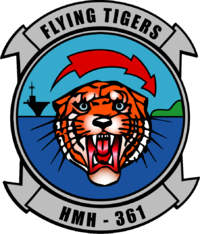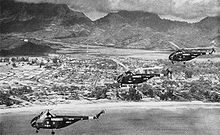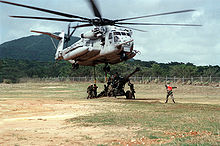- HMH-361
-
Marine Heavy Helicopter Squadron 361 
HMH-361 insigniaActive - February 25, 1952 - present
Country United States Branch USMC Type Marine Heavy Helicopter Squadron Role Assault Support Part of Marine Aircraft Group 16
3rd Marine Aircraft WingGarrison/HQ Marine Corps Air Station Miramar Nickname "Flying Tigers" Tail Code YN Engagements Vietnam War
Operation Enduring Freedom
Operation Iraqi FreedomCommanders Current
commanderLtCol Jay M. Holtermann Marine Heavy Helicopter Squadron 361 (HMH-361) is a United States Marine Corps helicopter squadron consisting of CH-53E Super Stallion transport helicopters. The squadron, known as the "Flying Tigers", is based at Marine Corps Air Station Miramar, California and falls under the command of Marine Aircraft Group 16 (MAG-16) and the 3rd Marine Aircraft Wing (3rd MAW).
Contents
History
Early years
HMH-361 was initially commissioned as Marine Transport Squadron 361 on February 25, 1952 at what was then Marine Corps Air Station Santa Ana, California. The "Flying Tigers" were attached to the only helicopter group in the Marine Corps, Marine Air Group (HR) - 16. At that time, the squadron consisted of only three OY-2 and one HRS-2 helicopters located at Marine Corps Air Station El Toro. The original mission of the squadron was to train for and improve upon amphibious ship-to-shore tactics. An additional mission was training replacement pilots for duty in the Korean War.
Shortly thereafter the squadron undertook its first major operation, to provide support for the atomic test exercise at Desert Rock, Nevada which is still the largest helicopter operation in history. Upon their return, HMR-361 was transferred to the newly established MAG (HR)-36 at MCAF Santa Ana in 1953. On December 31, 1956, the squadron was redesignated HMR(l)-361 and was now flying the HRS-3 helicopter. The Flying Tigers participated in two more atomic bomb testing exercises, beginning in June 1957 and February 1958.
In September 1958, the squadron began flying the H-34 helicopter and in 1960 performed the first West Coast parachute drop for Marine Pathfinders from the H-34. On February 1, 1962, the Flying Tigers were redesignated HMM-361 according to a Marine Corps wide redesignation for all H-34 squadrons. HMM-361 deployed for the Cuban Missile Crisis on October 27, 1962 in support of the 5th Marine Expeditionary Force on board the USS Iwo Jima (LPH-2).
Vietnam War
In June 1963, the Flying Tigers were deployed to Okinawa, Japan. The one-year deployment was cut short, however, when the squadron was transferred to Da Nang, Republic of Vietnam, as one of the first units in country, to participate in Operation Shufly. It was there that HMM-361 earned the nickname "Ross's Rice Runners", after their Commanding Officer, LtCol Tom Ross. On August 12, 1965 the squadron conducted the first nighttime helicopter assault by Marines during the war when they lifted 2nd Battalion, 3rd Marines into a landing zone 10 miles northwest of Danang during Operation Midnight.[1] On September 3, 1967, HMM-361 had 17 of its aircraft destroyed by enemy artillery while they were parked at Dong Ha. This incident would lead to their transfer south to the Marble Mountain Air Facility.[2] The squadron served in Vietnam until being transferred back to the U.S. and attached to Marine Aircraft Group 26 at Marine Corps Air Station New River, North Carolina. It was there that the squadron transitioned to the CH-53A Sea Stallion helicopter and was redesignated Marine Heavy Helicopter Squadron, HMH-361. They were again ordered to Vietnam with Marine Aircraft Group 36 at Phu Bai in 1969 and remained there until their return to the newly redesignated Marine Corps Air Station (H) Santa Ana, CA in 1970 as part of Marine Aircraft Group 56.
Postwar and the 1980s
HMH-361 received their first CH-53D Sea Stallion helicopter in 1977, and on June 1, 1979 made their first squadron to deploy overseas as part of the new Unit Deployment Program, completing the first of twelve, six month WestPac deployments on December 3, 1979.
In October 1984 the squadron became the first 3rd MAW helicopter squadron to train under the squadron training exercise and employment plan. Finishing this training in May 1985, HMH-361 attained the highest Marine Corps Combat Readiness Evaluation System (MCCRES) grade to date for a rotary wing squadron. During the squadron's ensuing six WestPac deployments under the UDP, HMH-361 accomplished the first over water flight to NAS Cubi Point, Republic of the Philippines.
The 1990s
Marine Heavy Helicopter squadron 361 began conversion to the CH-53E Super Stallion on August 23, 1990. On November 5, 1992, the Flying Tigers deployed to Okinawa as the Aviation Combat Element (ACE) of the 31st Marine Expeditionary Unit, the first MEU to utilize a CH-53E squadron as the nucleus. Here they were joined by detachments of CH-46E's from HMM-262, AH-1W's, and UH-1N's from HMLA-267, and AV-8B's from VMA-311 to become HMH-361 (REIN), the first CH-53E composite squadron in history.
The Flying Tigers again made history in November 1994 when they were quadruple sited while on their tenth deployment to Okinawa. Detachments were sent to the 13th and 31st MEU's, the Special Purpose Marine Air-Ground task force in support of Operation United Shield while the main body remained on Okinawa.
In August 1995, the Flying Tigers were awarded the Marine Corps Aviation Association's Keith B McCutcheon award as Marine Heavy Helicopter squadron of the year and in June 1996 were awarded the 1995 CNO Aviation Association Safety Award.
After returning from Okinawa and reintegrating its MEU detachments in May 1997, HMH-361 assumed the Alert Contingency Marine air-ground task force (ACM) status. Once again the Flying Tigers were awarded the Marine Corps Aviation Association's Keith B McCutcheon award as Marine Heavy Helicopter squadron of the year. The squadron also supported HMX-1 and the President of the United States, transporting three CH-53E's to San Carlos de Barioche, Argentina, aboard Air Force C-5 Galaxy aircraft.
Global War on Terror
On January 26, 2005, a CH-53E Super Stallion from HMH-361 crashed near Ar Rutbah, Iraq killing all 31 service members on board.[3]
In August 2010 HMH-361 deployed to Afghanistan in support of Operation Enduring Freedom. They are based at Camp Leatherneck and are due to return to the States in Early 2011.
See also
- United States Marine Corps Aviation
- Organization of the United States Marine Corps
- List of active United States Marine Corps aircraft squadrons
Notes
- ^ "The Marines in Vietnam 1965: The Landing and the Buildup". The Ohio State University. http://ehistory.osu.edu/osu/books/1965/index.cfm?page=0158. Retrieved 2009-05-06.
- ^ Coan (2004), p.172.
- ^ "Incident Date 050126 HMH-361 CH-53E - BuNo unknown - incident not yet classified - near Ar Rutbah, Iraq". Marine Corps Combat Helicopter Association. http://www.popasmoke.com/kia/incidents.php?incident_id=278&conflict_id=32. Retrieved 2007-11-20.
References
 This article incorporates public domain material from websites or documents of the United States Marine Corps.
This article incorporates public domain material from websites or documents of the United States Marine Corps.
- Bibliography
- Coan, James P. (2004). Con Thien - Hill of Angels. Tuscaloosa, Alabama: The University of Alabama Press. ISBN 0-81731-414-8.
- Web
MAG-11 
MAG-13 MAG-16 MAG-39 MACG-38 MWSG-37 Categories:- United States Marine Corps helicopter squadrons
Wikimedia Foundation. 2010.




